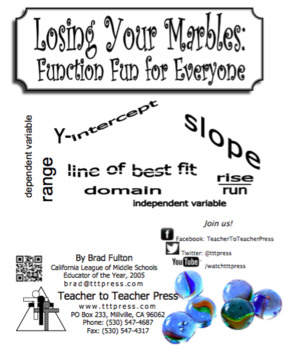Losing Your Marbles: Function Connections You Can See
Teacher to Teacher Press
482 Followers
Grade Levels
6th - 9th, Homeschool
Subjects
Resource Type
Standards
CCSS6.EE.B.7
CCSS6.EE.C.9
CCSS7.EE.B.4a
CCSS8.F.A.1
CCSS8.F.A.2
Formats Included
- PDF
Pages
5 pages
Teacher to Teacher Press
482 Followers
Description
This visual demonstration/lab helps students make complete sense of functions. Topics addressed include slope, y-intercept, rise & run, slope-intercept form, domain & range, independent & dependent variables, and line of best fit. Whole number, fractional, and positive and negative slopes are addressed.
Adaptations make the lesson accessible to both younger and more advanced students.
The download includes complete instructions, activity masters, answer keys, Common Core alignment, and research tip.
Adaptations make the lesson accessible to both younger and more advanced students.
The download includes complete instructions, activity masters, answer keys, Common Core alignment, and research tip.
Total Pages
5 pages
Answer Key
Included
Teaching Duration
4 days
Report this resource to TPT
Reported resources will be reviewed by our team. Report this resource to let us know if this resource violates TPT’s content guidelines.
Standards
to see state-specific standards (only available in the US).
CCSS6.EE.B.7
Solve real-world and mathematical problems by writing and solving equations of the form 𝘹 + 𝘱 = 𝘲 and 𝘱𝘹 = 𝘲 for cases in which 𝘱, 𝘲 and 𝘹 are all nonnegative rational numbers.
CCSS6.EE.C.9
Use variables to represent two quantities in a real-world problem that change in relationship to one another; write an equation to express one quantity, thought of as the dependent variable, in terms of the other quantity, thought of as the independent variable. Analyze the relationship between the dependent and independent variables using graphs and tables, and relate these to the equation. For example, in a problem involving motion at constant speed, list and graph ordered pairs of distances and times, and write the equation 𝘥 = 65𝘵 to represent the relationship between distance and time.
CCSS7.EE.B.4a
Solve word problems leading to equations of the form 𝘱𝘹 + 𝘲 = 𝘳 and 𝘱(𝘹 + 𝘲) = 𝘳, where 𝘱, 𝘲, and 𝘳 are specific rational numbers. Solve equations of these forms fluently. Compare an algebraic solution to an arithmetic solution, identifying the sequence of the operations used in each approach. For example, the perimeter of a rectangle is 54 cm. Its length is 6 cm. What is its width?
CCSS8.F.A.1
Understand that a function is a rule that assigns to each input exactly one output. The graph of a function is the set of ordered pairs consisting of an input and the corresponding output.
CCSS8.F.A.2
Compare properties of two functions each represented in a different way (algebraically, graphically, numerically in tables, or by verbal descriptions). For example, given a linear function represented by a table of values and a linear function represented by an algebraic expression, determine which function has the greater rate of change.





